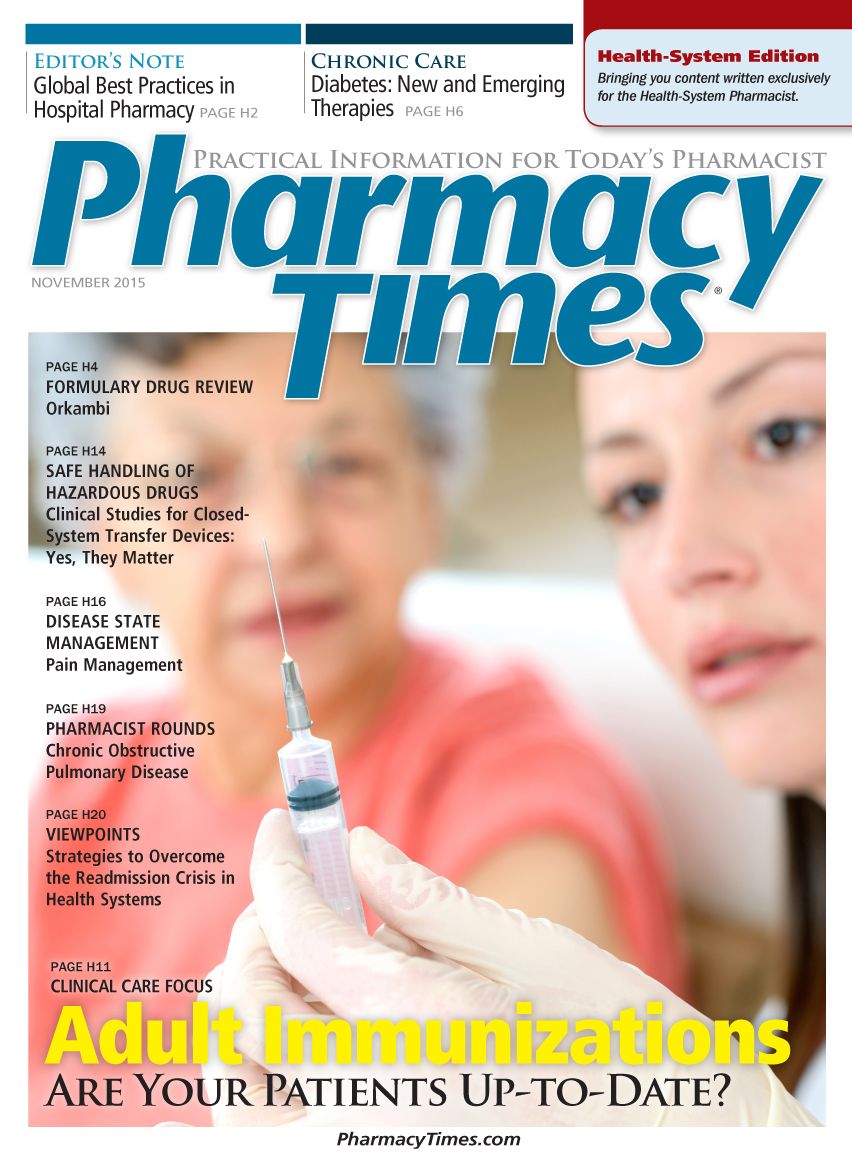Publication
Article
Pharmacy Practice in Focus: Health Systems
Orkambi
Orkambi is a new combination medication to treat cystic fibrosis in patients 12 years and older who are homozygous for the F508del mutation on the CF transmembrane conductance regulator CFTR gene.
BACKGROUND1,2
Orkambi (lumacaftor/ivacaftor), manufactured by Vertex Pharmaceuticals, is a new combination medication to treat cystic fibrosis (CF) in patients 12 years and older who are homozygous for the F508del mutation on the CF transmembrane conductance regulator CFTR gene. This specific mutation is present in nearly half of patients with CF, and Orkambi is the first medication to treat the underlying cause of CF in this group. CF is a serious genetic disorder that results in the buildup of mucus in the lungs and digestive tract, which causes respiratory, digestive, and other severe complications. Orkambi was approved by the FDA on July 2, 2015. It received breakthrough therapy designation, priority review, and orphan drug designation due to the novel benefits that it could potentially offer.
PHARMACOLOGY/ PHARMACOKINETICS1,3,4
The CFTR protein is an anion channel at the surface of epithelial cells that transports chloride. The F508del mutation produces a misfolded CFTR protein, which decreases the number of proteins capable of reaching the cell surface. The few proteins that do reach the cell surface have defective gating activity. Lumacaftor improves the stability of F508del- CFTR, allowing more proteins to reach the cell surface. Ivacaftor is a CFTR potentiator, which improves functionality of the protein by increasing the ability of the channel to open. This combination improves chloride transport, thus increasing secretions in the lung and gastrointestinal tract.
Exposure of lumacaftor and ivacaftor was approximately 2 and 3 times higher, respectively, when administered with a highfat meal compared with on an empty stomach. The mean volume of distribution of lumacaftor and ivacaftor is 86 L and 353 L, respectively, and both are approximately 99% bound to plasma proteins. The half-life of lumacaftor and ivacaftor is 26 hours and 9 hours, respectively.
DOSING AND ADMINISTRATION1,4
Each Orkambi tablet contains 200 mg lumacaftor and 125 mg ivacaftor. Adults and children 12 years and older should take 2 tablets by mouth every 12 hours with fat-containing foods such as peanut butter, whole-milk dairy products, eggs, nuts, or butter. Patients with moderate hepatic impairment (Child-Pugh Class B) should receive a dose reduction of 2 tablets in the morning and 1 tablet in the evening. Patients with severe hepatic impairment should use Orkambi with caution if it is determined that the benefit of use outweighs the risk, and the dose should be limited to a maximum of 1 tablet twice a day. A dosage reduction during initiation of Orkambi is required for patients receiving strong CYP3A inhibitors (1 tablet daily for 1 week).
CLINICAL EFFICACY3
The basis for FDA approval of Orkambi were 2 almost identical studies (TRAFFIC and TRANSPORT), both of which were phase 3, randomized, double-blind, parallel group, placebo-controlled studies. Patients were randomized to 1 of 3 groups: lumacaftor 600 mg once daily and ivacaftor 250 mg every 12 hours, lumacaftor 400 mg and ivacaftor 250 mg every 12 hours, or a matched placebo. Patients received the assigned medications in addition to their current prescribed therapies. All 1108 patients were at least 12 years old and homozygous for the F508del CFTR mutation. Because the FDAapproved dosage of Orkambi is lumacaftor 400 mg and ivacaftor 250 mg every 12 hours, the remaining discussion refers to this group as the “treatment group.”
The TRAFFIC and TRANSPORT studies provide similar results, and the following data represent a pooled analysis. The primary outcome of absolute change in predicted forced expiratory volume in 1 second from baseline to week 24 was a mean difference of 2.8% in the treatment versus the placebo groups (95% CI, 1.8-3.8; P <.001). The number of pulmonary exacerbations, a secondary endpoint, was 41.2% in the treatment group versus 67.7% in the placebo group (P <.001). Treatment patients also experienced an increase in body mass index (BMI). The difference versus placebo in absolute change in BMI was 0.24% (95% CI, 0.11- 0.37; P <.001).
MEDICATION SAFETY3,4
According to the TRAFFIC and TRANSPORT studies’ results, 17.3% of treatment patients and 28.6% of placebo patients reported at least 1 serious adverse event (AE), with the most common serious AE being infective pulmonary exacerbation. Other reported AEs were predominantly respiratory-related, such as dyspnea and chest tightness. Additionally, because serious abnormal liver function events have been reported, liver function tests should be administered periodically to monitor alanine aminotransferase, aspartate aminotransferase, and bilirubin.
AVAILABILITY AND COST1,5
Each Orkambi tablet is pink and oval-shaped. One box contains 112 tablets enclosed in blister strips. Tablets should be stored at 20° to 25°C (68°-77°F). The wholesale acquisition cost per dose (2 tablets) is $354.80, equating to an annual cost of $259,000 per year.
Jennifer L. Cruz, PharmD, BCPS, is an assistant professor of clinical education at UNC Eshelman School of Pharmacy. Katherine Summers is a PharmD candidate at UNC Eshelman School of Pharmacy.
References
- Orkambi [package insert]. Cambridge, MA: Vertex Pharmaceuticals; 2015.
- FDA approves new treatment for cystic fibrosis [news release]. Silver Spring, MD: FDA; July 2, 2015. www.fda.gov/NewsEvents/Newsroom/PressAnnouncements/ucm453565.htm. Accessed August 5, 2015.
- Wainwright CE, Elborn JS, Ramsey BW, et al; TRAFFIC Study Group; TRANSPORT Study Group. Lumacaftor-ivacaftor in patients with cystic fibrosis homozygous for Phe508del CFTR. N Engl J Med. 2015;373(3):220-231. doi: 10.1056/NEJMoa1409547.
- Orkambi. Lexicomp [online database]. Hudson, OH: Wolters Kluwer Health; July 2015. Accessed August 5, 2015.
- Pricing obtained from Vertex Pharmaceuticals Medical Information representative.







